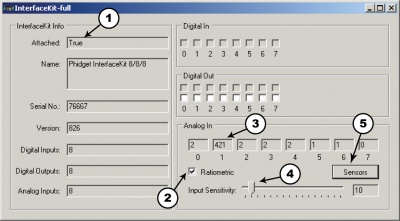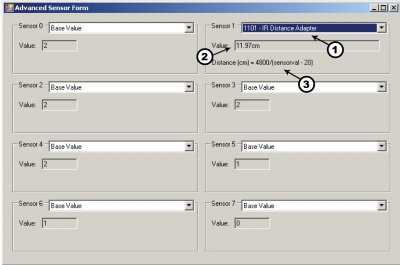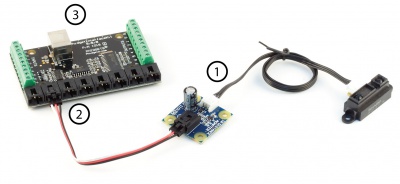|
Notice: This page contains information for the legacy Phidget21 Library. Phidget21 is out of support. Bugfixes may be considered on a case by case basis. Phidget21 does not support VINT Phidgets, or new USB Phidgets released after 2020. We maintain a selection of legacy devices for sale that are supported in Phidget21. We recommend that new projects be developed against the Phidget22 Library.
|
1101 User Guide

| |
| Go to this device's product page |
Getting Started
Checking the Contents
|
You should have received:
|
In order to test your new Phidget you will also need:
| |
Connecting the Pieces
|
| |
Testing Using Windows 2000 / XP / Vista / 7
Make sure you have the current version of the Phidget library installed on your PC. If you don't, follow these steps:
- Go to the Quick Downloads section on the Windows page
- Download and run the Phidget21 Installer (32-bit, or 64-bit, depending on your system)
- You should see the
 icon on the right hand corner of the Task Bar.
icon on the right hand corner of the Task Bar.
Running Phidgets Sample Program
Double clicking on the ![]() icon loads the Phidget Control Panel; we will use this program to ensure that your new Phidget works properly.
icon loads the Phidget Control Panel; we will use this program to ensure that your new Phidget works properly.
The source code for the InterfaceKit-full sample program can be found in the quick downloads section on the C# Language Page. If you'd like to see examples in other languages, you can visit our Languages page.
Updating Device Firmware
If an entry in this list is red, it means the firmware for that device is out of date. Double click on the entry to be given the option of updating the firmware. If you choose not to update the firmware, you can still run the example for that device after refusing.
|
Double Click on the |

| |
|

| |
|

|
Testing Using Mac OS X
- Go to the Quick Downloads section on the Mac OS X page
- Download and run the Phidget OS X Installer
- Click on System Preferences >> Phidgets (under Other) to activate the Preference Pane
- Make sure that the Phidget InterfaceKit 8/8/8 is properly attached.
- Double Click on Phidget InterfaceKit 8/8/8 in the Phidget Preference Pane to bring up the InterfaceKit-full Sample program. This program will function in a similar way as the Windows version.
Using Linux
For a step-by-step guide on getting Phidgets running on Linux, check the Linux page.
Using Windows Mobile / CE 5.0 / CE 6.0
For a step-by-step guide on getting Phidgets running on Windows CE, check the Windows CE page.
Technical Details
The function of the IR Distance Adapter Board is to regulate the power requirement of the connected sensor. Although the specified current consumption may be low for these types of sensors, they may draw much more current for short periods of time during measurements. If two or more of these sensors are directly connected to the analog inputs of a PhidgetInterfaceKit, (which can source a maximum of 500mA current total) then the InterfaceKit may potentially experience an overload. Up to eight Sharp IR Distance sensors can safely be connected to the PhidgetInterfaceKit 8/8/8 at the same time through IR Distance Adapter Boards, which prevents the possibility of overcurrent.
Sharp IR distance sensors are recommended for use with the IR Distance Adapter board. The sensor values given will be outside the specified range when no object is present, and fall between a specific range when an object isdetected. For analog type sensors, the output is roughly inversely proportional to the distance between the specific range. For digital type sensors, output below a certain value can be treated as a detection.
Make sure that the distance of the object being measured is within the distance range of the sensor. When the object is outside the valid sensor’s distance range, the returned value should be discarded. You must be especially careful when the object is closer than it should be, as the returned value might be within the SensorValue range but is not meaningful. If the sensor is being used outdoors, be mindful that sunlight can cause interference, especially when the sunlight is entering at such an angle that it is within the sensor's cone of detection. The IR light from these sensors can pass through glass, but only if the glass is completely clear and the sensor is perpendicular and very close to the surface of the glass. Otherwise, too much IR light will be reflected for the sensor to work properly.
Formulas
These formulas are derived from the Sharp datasheets to compute distance and are only valid for the Sharp Distance Sensors that we stock and sell on Phidgets.com.
- 3520 - Sharp Distance Sensor 2D120X (4-30cm)
- 3521 - Sharp Distance Sensor 2Y0A21 (10-80cm)
- 3522 - Sharp Distance Sensor 2Y0A02 (20-150cm)
The formula to translate SensorValue into Distance for Sharp 4-30cm analog sensor is:
- Distance (cm) = 2076/(SensorValue - 11)
- This formula is only valid over the SensorValue range 80-530.
The formula to translate SensorValue into Distance for Sharp 10-80cm analog sensors is:
- Distance (cm) = 4800/(SensorValue - 20)
- This formula is only valid over the SensorValue range 80-500.
The formula to translate SensorValue into Distance for Sharp 20-150cm analog sensors is:
- Distance (cm) = 9462/(SensorValue - 16.92)
- This formula is only valid over the SensorValue range 80-490.
For digital distance sensors, SensorValue will be greater than 200 if the distance of the object being measured is less that the detection distance of the sensor. Otherwise the SensorValue will be less that 200.
Note: The output of this sensor will vary from unit to unit, and based on the characteristics of the target (reflectance, size, direction of motion, object alignment, etc). Our formula is based on the data provided by Sharp. If you find that you are not getting good results with the standard formulas, you may want to derive your ownformula to better characterize your situation.
Compatible Infrared Sensors
The following is a list of distance sensors that are known to work with the IR Distance Adapter Board. If the product is not listed here, it can be assumed to be incompatible.
| Manufacturer | Part Number | Description |
|---|---|---|
| Sharp | GP2Y0A02YK0F | 20-150cm Analog |
| Sharp | GP2Y0A02YK | 20-150cm Analog (non-RoHS) |
| Sharp | GP2Y0D21YK0F | 24cm Digital |
| Sharp | GP2Y0D21YK | 24cm Digital (non-RoHS) |
| Sharp | GP2D14J0000F | 24cm Digital |
| Sharp | GP2D15 | 24cm Digital (non-RoHS) |
| Sharp | GP2Y0D02YK0F | 80cm Digital |
| Sharp | GP2Y0D02YK | 80cm Digital (non-RoHS) |
| Sharp | GP2D150AJ00F | 15cm Digital |
| Sharp | GP2D140A | 15cm Digital (non-RoHS) |
| Sharp | GP2Y0A21YK0F | 10-80cm Analog |
| Sharp | GP2D12 | 10-80cm Analog (non-RoHS) |
| Sharp | GP2Y0A21YK | 10-80cm Analog (non-RoHS) |
| Sharp | GP2D120XJ00F | 4-30cm Analog |
| Sharp | GP2D120 | 4-30cm Analog (non-RoHS) |
Other Interfacing Alternatives
If you want maximum accuracy, you can use the RawSensorValue property from the PhidgetInterfaceKit. To adjust a formula, substitute (SensorValue) with (RawSensorValue / 4.095) If the sensor is being interfaced to your own Analog to Digital Converter and not a Phidget device, our formulas can be modified by replacing (SensorValue) with (Vin * 200). It is important to consider the voltage reference and input voltage range of your ADC for full accuracy and range.
|
Each Analog Input uses a 3-pin, 0.100 inch pitch locking connector. Pictured here is a plug with the connections labelled. The connectors are commonly available - refer to the Analog Input Primer for manufacturer part numbers. |

| |
API
Phidget analog sensors do not have their own API- they simply output a voltage that is converted to a digital value and accessed through the "Sensor" properties and events on the PhidgetInterfaceKit API. It is not possible to programmatically identify which sensor is attached to the Analog Input. To an InterfaceKit, every sensor looks the same. Your application will need to apply formulas from this manual to the SensorValue (an integer that ranges from 0 to 1000) to convert it into the units of the quantity being measured. For example, this is how you would use a temperature sensor in a C# program:
// set up the interfacekit object
InterfaceKit IFK = new InterfaceKit();
// link the new interfacekit object to the connected board
IFK.open("localhost", 5001);
// Get sensorvalue from analog input zero
int sensorvalue = IFK.sensors[0].Value;
// Convert sensorvalue into temperature in degrees Celsius
double roomtemp = Math.Round(((sensorvalue * 0.22222) - 61.11), 1);
See the PhidgetInterfaceKit User Guide for more information on the API and a description of our architecture.
For more code samples, find your preferred language on the Languages page.
Product History
| Date | Board Revision | Device Version | Comment |
|---|---|---|---|
| October 2005 | 0 | N/A | Product Release |
| May 2008 | 0A | N/A | Redesign due to component obsolescence |

